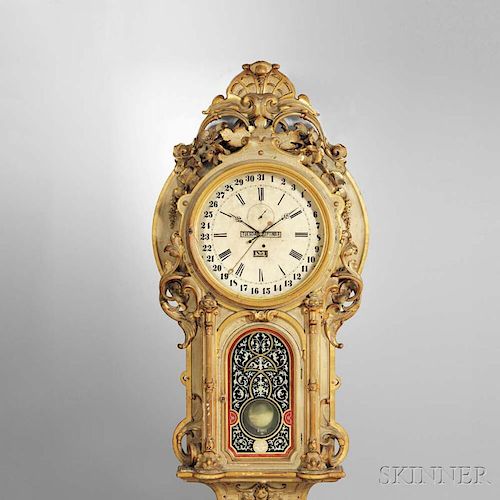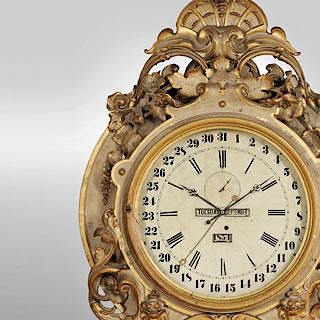Monumental Carved and Gilded Perpetual Calendar Wall Clock
Lot 718
About Seller
Bonhams Skinner
274 Cedar Hill Street
Marlborough, MA 01752
United States
Founded over four decades ago, Bonhams Skinner offers more than 60 auctions annually. Bonhams Skinner auctions reach an international audience and showcase the unique, rare, and beautiful in dozens of categories, including the fine and decorative arts, jewelry, modern design, musical instruments, sc...Read more
Categories
Estimate:
$25,000 - $45,000
Absentee vs Live bid
Two ways to bid:
- Leave a max absentee bid and the platform will bid on your behalf up to your maximum bid during the live auction.
- Bid live during the auction and your bids will be submitted real-time to the auctioneer.
Bid Increments
| Price | Bid Increment |
|---|---|
| $0 | $10 |
| $100 | $25 |
| $500 | $50 |
| $1,000 | $100 |
| $3,000 | $250 |
| $5,000 | $500 |
| $10,000 | $1,000 |
| $30,000 | $2,500 |
| $50,000 | $5,000 |
| $100,000 | $10,000 |
| $300,000 | $25,000 |
| $500,000 | $50,000 |
| $1,000,000 | $100,000 |
About Auction
By Bonhams Skinner
Oct 28, 2016 - Oct 29, 2016
Set Reminder
2016-10-28 10:00:00
2016-10-29 10:00:00
America/New_York
Bidsquare
Bidsquare : Clocks, Watches & Scientific Instruments
https://www.bidsquare.com/auctions/skinner/clocks-watches-scientific-instruments-1832
Bonhams Skinner bidsquare@bonhamsskinner.com
Bonhams Skinner bidsquare@bonhamsskinner.com
- Lot Description
Monumental Carved and Gilded Perpetual Calendar Wall Clock, Calendar Clock Company, Hartford, Connecticut, c. 1855, patented September 19, 1854, from the Grand Union Hotel, Saratoga Springs, New York, demolished in 1953, the hand-carved hardwood case (probably cherry) painted pearl white on the exterior with all carving gilded, applied top crest with floral and acanthus leaf baroque carving extending with scrolls below the dial and buttress carving to the gilded pedestal, the 24-in. dia. zinc roman numeral dial with apertures for the day-of-the-week, month, and year operable until 1949, with center hand for day-of-the-month along the outer perimeter, the lower hinged door with gold leaf and mother-of-pearl scrolled designs with aperture for pendulum and marked Calendar Clock Co./Hartford, Conn./Patented September 19./1854. within a round maker's boss, heavy, 12-in. high, eight-day, brass, weight-powered timepiece with deadbeat escapement, mounted to an iron frame within the case powered by a brass-cased compounded weight, overall ht. 84 in.; wd. through dial center 42 in.
Provenance: Grand Union Hotel, Saratoga, New York, from approximately 1855 to the demolition of the hotel in 1953. The clock went to the furnishings of the Grand Union Hotel auction, was purchased by the Destito family and installed at their establishment, "The Beeches," in Rome, New York.
Literature: NAWCC Bulletin, 1954, pp. 244-245. The present clock is illustrated and past history discussed in this "Vox Temporis" segment.
Note: By 1870, the Grand Union Hotel was the largest hotel in the world with just over 2,000 rooms. This clock hung in the main foyer where the elite, including millionaires, governors, senators, congressmen, judges, presidents, and literary figures, and many others checked their watches against the time of this clock. An elegant summer lifestyle centered at the Grand Union, which included mineral springs, racehorses, cocktails, and the cool night breezes.
The undisputed authority on Connecticut clocks (and most other clocks as well), Chris Bailey, retired curator of the American Clock and Watch Museum, wrote the consignor on November 18, 2008, discussing the four different patents which relate to this clock dating 1854, 1855, and two in 1856 and included copies of the patents in this correspondence; a copy is available to the purchaser.
Estimate $25,000-45,000
The absence of a condition statement does not imply that the lot is in perfect condition or completely free from wear and tear, imperfections or the effects of aging. Condition requests can be obtained via email (lot inquiry button) or by telephone to the appropriate gallery location (Boston/617.350.5400 or Marlborough/508.970.3000). Any condition statement given, as a courtesy to a client, is only an opinion and should not be treated as a statement of fact. Skinner Inc. shall have no responsibility for any error or omission. - Shipping Info
-
Please visit http://www.skinnerinc.com/services/payment-and-shipping/ for information regarding the collection of items purchased at auction.
-
- Buyer's Premium



 EUR
EUR CAD
CAD AUD
AUD GBP
GBP MXN
MXN HKD
HKD CNY
CNY MYR
MYR SEK
SEK SGD
SGD CHF
CHF THB
THB


























